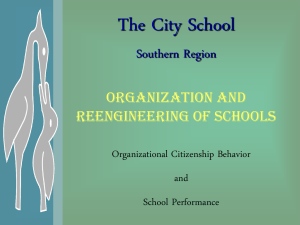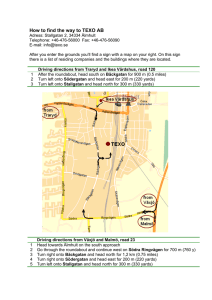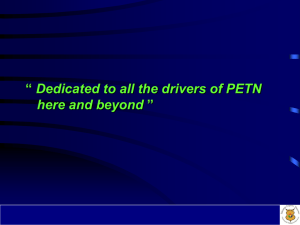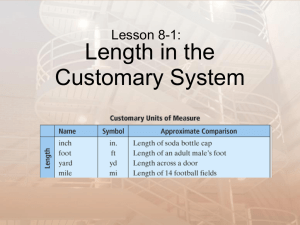CASE STUDY ON URBAN DEVELOPMENT IN BLOCK H AND L
advertisement
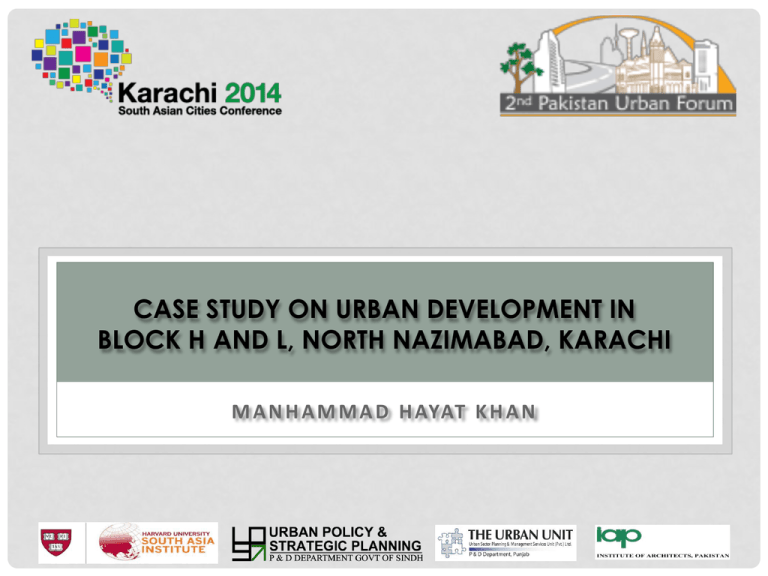
CASE STUDY ON URBAN DEVELOPMENT IN BLOCK H AND L, NORTH NAZIMABAD, KARACHI M A N H A M M A D H AYAT K H A N OBJECTIVE The presentation examines the urban development and its impact in Bock H and L, North Nazimabad, Karachi. As North Nazimabad is of the well planned localities of Karachi and in terms of aesthetics, amenities, and grandeur, no other locality in Pakistan could match the town planning of North Nazimbad. The increase in commercialization and demand of housing in North Nazimabad Block H and L, the planned blocks are now facing urban challenges in terms of traffic jams, parking issues, noise pollution, inadequate water supply, drainage problems and congestion. INTRODUCTION • The world is undergoing the largest wave of urban growth • By 2030, almost 5 billion people will be living in towns and cities, with urban development concentrated in Africa and Asia • By 2030, it is estimated that nearly half of the Pakistan’s population will be living in the urban areas and about 17 cities will have a population of more than one million • The increase in urban population is attributed to either continued rural to urban migration or natural increase • As a consequence of the above increase in population the urban living conditions are under great pressure • Karachi, the economic hub of Pakistan is also going through the process of urban development and thus facing urban challenges INTRODUCTION • Pakistan’s current population is about one-third urban. However, that figure will rise to nearly 50% by 2025. • More than 60 percent of the population of urban Sindh lives in Karachi and this concentration has increased over time. • Karachi is growing so fast that estimates of its population range from 12 million to 18 million. NORTH NAZIMABAD • In 2001, North Nazimabad was declared as one of the 18 towns of Karachi • Locality / Township of North Nazimabad was planned to house Federal government employees when Karachi was capital of Pakistan • In 1962, the capital was shifted from Karachi to Islamabad and the planned neighborhood of North Nazimabad became available to general public instead of originally planned employees of Federal government only North Nazimabad Town Boundary of North Nazimabad NORTH NAZIMABAD • North Nazimabad consists of 20 residential blocks identified with alphabets from A to T • North Nazimabad of today boasts of at least four First-Class cricket grounds, several hospitals, a medical and dental university, several higher secondary colleges, Taimuria library, several parks and sustained commercial activity which makes it a complete city within the city. BLOCK H & L PROFILE (STUDY AREA) • The 1 km long and 150 feet wide strip between Block H and L of North Nazimabad known as Shahra-e-Jahangir has been developed as a vibrant urban space. • This strip is also experiencing growth as well, and multistory towers are seen to change the skyline of a previously residential neighborhood. • Block H and L of North Nazimabad is facing urban problems and challenges due to this commercialization and development of multistory towers and walkups LAYOUT PLAN OF BLOCK H AND L, NORTH NAZIMABAD METHODOLOGY • • • • • • • • Review of literature Collection of qualitative and quantitative data through field surveys Questionnaire Interviews from residents, shop keepers and booking officers Capturing photographs and co-ordinates GIS Mapping GIS Analysis Softwares Used; ArcGIS 10.0, AutoCAD 2010, Google Earth Pro RESULTS • Block H and L of North Nazimabad of today have lost much of its past glory. like many localities of big cities, businesses from city center slowly creep into residential areas • The once peaceful residential locality of North Nazimabad is now fast turning into a commercial market • Significant percentage of large size plots (area>400 Sq. yards) of block H and L have seen change in land use from residential to some private school, private University, marriage lawns, fast food centers, medical centers • Another major landuse change in Block H and L of North Nazimabad is the development of high-rise (multi story) residential buildings • During survey 7 new high rise projects were identified. Many of them are completed and booked and residents have started living there and the under construction projects have already been booked before the foundation has been laid RESULTS S. Project Name Status No. 1 Floor s Saima Grand Under 12 Construction 2 Mahnoma Constructed 1277 Sq. Yards 7 Heights 3 Area 650 Sq. Yards Sheikh Heights Constructed 10 1250 Sq. Yards 4 Habib Pride Constructed 7 600 Sq. Yards 5 Burj View Under 12 Construction 6 7 Euro Clock Under Tower Construction Ajwa Under Apartments Construction 1200 Sq. Yards 7 600 Sq. Yards 7 1000 Yards Sq. RESULTS • Uncontrolled walkups is posing a serious issue of densification • The increase in population is highly affecting the infrastructure of block H and L • Water supply, electricity supply, drainage, sanitation is over burdened • At the other hand there is increase in load on hospitals, dispensaries, parks, play grounds and most importantly result in lengthy and frequent traffic jams • Many high rises are without parking facilities this will create traffic jam on the main road as it is already a food street with no parking facility Walkups LAYOUT PLAN OF NORTH NAZIMABAD (BLOCK H AND L) COMMERCIALIZATION INCREASES DEVELOPMENT OF GROUND+1 AND GROUND+2 WALKUPS STARTED DEVELOPMENT OF HIGH RISES (MULTI STORY) PROJECTS RESULTS Open Spaces • Open spaces/amenity plots are not developed in a manner to encourage public use and recreation • The playgrounds and parks are being encroached and land mafia is grabbing the land of playground day by day, reducing its size which can be easily seen in yellow polygons Encroachment on open spaces RESULTS • Irregular Land use, Such as batching plants in amenity plots is creating environmental pollution and utilizing public space. Marriage lawn on Sharah-eJahangir, is too narrow to accommodate flash in flux of arriving and departing guests Batching plant in a JAFCO cricket ground near LandiKotal roundabout White house marriage lawn on main shahra-e-jahangir road PROPOSALS • Commercialization of strip has created a disjoint in land use and density • A large scale solution is needed to tackle this rupture in the overall city’s urban fabric • The planning agency could create a system of area wise land pooling where successful commercialization has taken place • The Authority Managed land pooling system could create transition zones such as walkups, plazas, parks between multistory and residential neighborhoods • It is proposed that in order to retain the quality of the neighborhood authority incentivized land pooling schemes should be launched. PROPOSALS • Transitional zones could be created to ease the stark differences and densities of development. Parallel roads could be established to create a shunt to separate residential and thoroughfare traffic. Transition Zone PROPOSALS • Regularization of illegal land use can be curtailed by creating a public vigilance cell where complaints about illegal land use/ construction could be reported and hence the local Authority observer kept under check • To increase development of new public amenities such as parks and cater for expansion of such facilities, the authority will have to ameliorate and amortize some plots. There are two types Illegally occupied to be returned to amenity Legally occupied to be consumed by amenity • Illegal occupants can be relocated in peri urban localities where planning agency would provide tenured housing units • Legal occupants could be bought out on market value, this could be achieved by creating a one time tax to residents of the block, or spread over a period of 3-5 years PROPOSALS CONCLUSION • Monetary value increase due to qualitative amendments The solution must be identified in terms of • Political Gain and Leverage • The gain from inclusive solutions (law & order and lack of court interventions)
